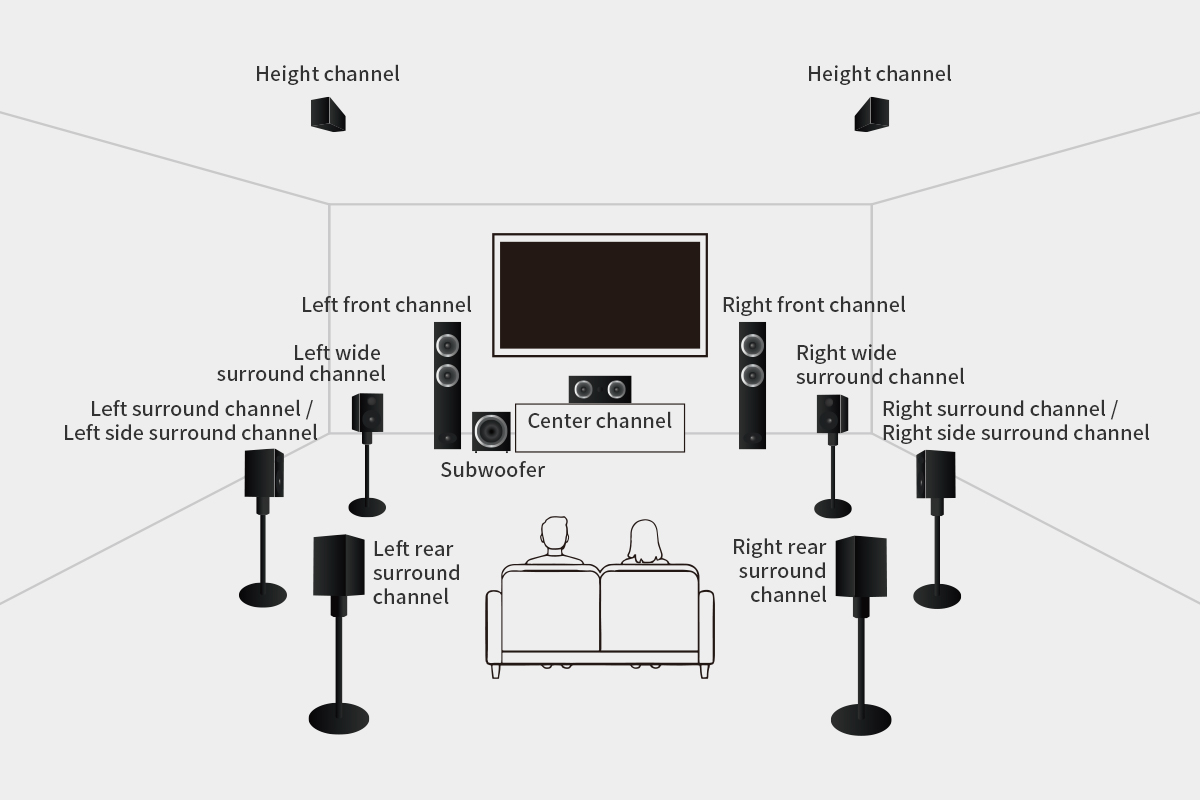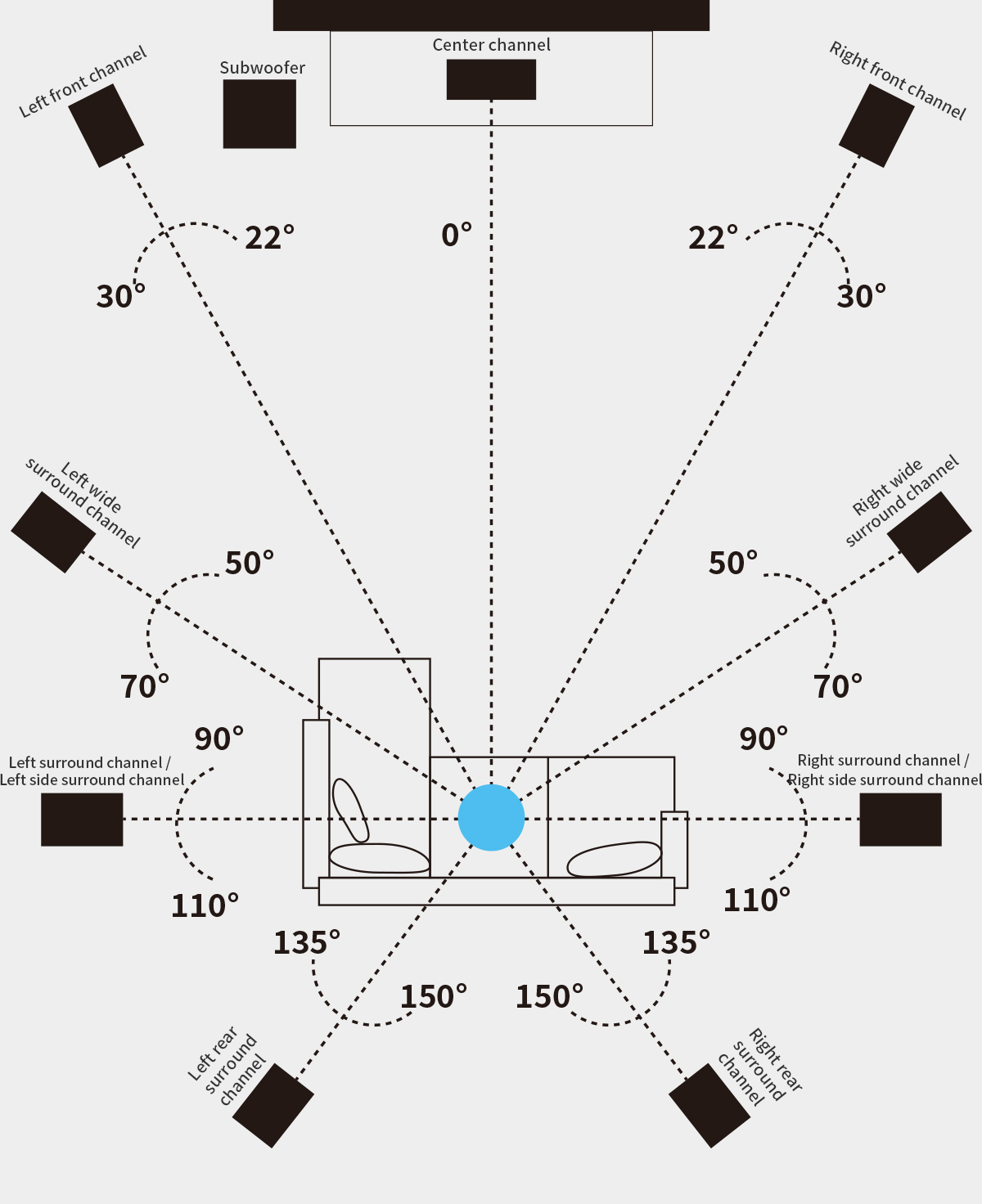- zhhivi@hivi.com
Beginner's Guide to Building a Surround Sound Home Theater

The core goal of a multi-channel sound system in home theater acoustic design is to achieve precise sound localization and immersive experience through the coordinated optimization of precise channel configuration and spatial layout. This sound reproduction process not only depends on the quality of hardware performance, but also requires a deep understanding of sound field modeling theory, psycho-acoustic principles, and digital signal processing technology.
In essence, the concept of "acoustic tract" defines the coordinate system of sound propagation in three-dimensional space. Taking the common 5.1.2, 7.1.4, or 9.1.6 channel systems as examples, their numerical identifiers have clear acoustic meanings, with "9", "7", or "5" representing the main speaker array in the horizontal direction on the ground floor, including:
● Left Front Channel
● Centre Channel
● Right Front Channel
● Left Wide Surround Channel (9.x.x)
● Right WIde Surround Channel (9.x.x)
● Left Surround Channel (5. x.x)/Left Side Surround Channel (7. x.x/9. x.x)
● Right Surround Channel (5. x.x)/Right Side Surround Channel (7. x.x/9. x.x)
● Left Rear Surround Channel (7. x.x/9. x.x)
● Right Rear Surround channel (7. x.x/9. x.x)
This set of speakers is mainly responsible for building a "horizontal" sound field, accurately reproducing the spatial positioning of key audio elements such as human voice dialogue and environmental sound effects.

「1」 Represents independent low-frequency effects (LFE) channels, typically played back by independent subwoofers. Its core function is to replay low-frequency signals within the range of 0-150Hz, which are specially designed by the mixer and exist in independent channels of the audio file. LFE signals are typically used to record the ultra-low parts of low-frequency effects such as explosions, earthquakes, or other sound effects, ensuring that these sounds with extremely high low-frequency energy can be fully restored. Note the easily confused fact that there can be multiple subwoofers, but there is only one LFE channel source in a multi-channel audio program. The number of audio channels and playback channels are not the same concept.
「2」 4 "or" 6 "represents the top" sky "speaker, used to construct a vertical sound field space. Through precise sound image localization, it is possible to simulate the sound effects from above or behind, such as rainfall and aircraft, significantly enhancing immersion.

This article will focus on the setup principles and optimization methods for front loudspeakers in the horizontal plane. Configuration essentials for subwoofers and overhead soundfields will be explored in-depth in subsequent features.
Front Left&Right Speakers
In the layout of a stereo system, the left and right front speakers are like the pillars of the entire sound stage. They stand in front of the audience, one on the left and one on the right, together building the basic framework of sound. When you are enjoying music or watching movies, the position of instruments, the movement of human voices, and even subtle sounds in the environment all rely on these speakers for precise positioning. It can be said that the performance of the left and right front speakers completely determines the listening experience of the entire audio system.
Due to the close correlation between the human ear's perception of sound localization and the direction of the sound source, especially for high-frequency signals with frequencies above 2kHz. Therefore, it is recommended to keep the installation height of the left/right front speakers consistent with the ear height of the listening position, with a vertical deviation controlled within ± 10 °. Based on the study of the minimum perceptible difference in vertical sound source localization by the human ear, within this range, the changes caused by significant height differences are usually imperceptible to the human ear. The recommended angle for the front speaker relative to the central axis is 30 °, forming a regular triangle with the sound system, left and right speakers. If the position is limited, this angle is also allowed to be between 22~30 °, of course, symmetrical placement is necessary.

When there are physical height limitations in the actual installation environment, acoustic compensation can be achieved by adjusting the vertical elevation angle of the speaker. It should be noted that due to the directional characteristics of high-frequency units, typically at frequencies above 1kHz, the radiation angle of the speaker gradually narrows as the frequency increases, and the directional characteristics of different designed high-frequency units also vary significantly. When the listening position deviates from the optimal radiation angle of the speaker, the frequency response of the sound will change, resulting in perceptible differences in sound quality. Therefore, a tilted horizontal speaker arrangement will never be recommended first, and precise sound axis alignment can ensure that direct sound energy is transmitted to the listening position through the optimal path, while minimizing the influence of early reflected sound, thereby achieving accurate sound image localization and clear spatial reproduction.
Centre Speaker
The center speaker is the anchor point of the entire sound field, responsible for stabilizing and enhancing the core positioning of sound. Ideally, it should be placed at the same height as the front left and right speakers, forming a stable front sound field array with them. This layout ensures the consistency of sound and image height.
From the perspective of audio production, the center speaker is mainly responsible for dialogue and dynamic sound effects in movies that do not require emphasis on positioning. The playback of the center speaker belongs to "real center", while the traditional playback of the sound in the center position by the left and right speakers is called "virtual center". The virtual effect is easily affected by the performance of the room or equipment, leading to the occurrence of the "hollow effect", and the sound imaging in the central position may deteriorate. The center channel can help firmly fix the sound in the center of the sound field, even if the audience deviates from the optimal listening position, they can still feel clear and stable sound image localization, without being affected by the left and right channel listening windows. Paired with surround sound speakers, it can also create a coherent three-dimensional sound field, allowing sound to naturally transition throughout the entire plane, creating a more immersive auditory experience.

Many times, due to layout limitations, the center speaker is placed directly above or below the screen. Once this situation occurs, it needs to be tilted at a certain angle to ensure that it can point towards the height of the human ear and compensate for the difference in layout height. Self adhesive rubber pads/bumper pads or isolation brackets can be used at the bottom of the center speaker for simple implementation. This is an easily overlooked but important adjustment step. Meanwhile, it is important to minimize contact with the container or furniture in which it is located.
Left/Right Side/Rear/Wide Surround speakers
All horizontal surround speakers, except for the front speaker, have the main function of enhancing the spatial and immersive sense of sound, and together with the front speakers (left front, center, right front), they construct a complete flat sound field. They are responsible for extending sound from the front to the entire plane, creating a coherent surround, and making the flow and transition of sound from all directions more natural.
For the horizontal layout of 5.1. x, 7.1. x, and 9.1. x, the difference in the number of speakers only lies in the precision of the specific speaker placement. More speakers can bring more sound sources and achieve more accurate positioning. For a system with 5 flat speakers, two surround speakers need to take on the task of locating the entire side rear sound source, so it is recommended to locate it at a position of 110-120 ° relative to the central axis. The 7/9 flat speaker system uses 4 speakers to complete such tasks, so the angles of the side and rear speakers are recommended to be within 90-110 ° and 135-150 ° relative to the central axis, respectively. For the layout of 9.1. x, there are two additional widened speakers, which are recommended to be positioned within a range of 50-70 ° relative to the central axis.

For surround sound systems, the angle relationship between the speakers and the listening position is very important. Relatively speaking, there is no strict limit on the distance between the speaker and the listening position, and differences are allowed to exist. Because the angle directly determines the accuracy of positioning, and the error in listening distance can be compensated for through delayed calibration of the calibration system - just ensure that the distance between the speaker and the listening position is within the manufacturer's recommended range. For example, coaxial speakers allow for closer placement, while conventional crossover designs require a certain distance (1-2 meters or more) to properly couple multiple units. Of course, the placement should still be as symmetrical as possible to meet the requirements.
For the installation height of surround speakers, it is usually recommended to be on the same plane as the front speakers. However, in a home theater environment, if the sofa backrest is too high or if multiple people need to listen, surround or surround rear speakers can be installed slightly above ear height and tilted slightly downwards to point towards the listener's ear. This tilt angle should not be too large, it is recommended to be within a deviation of 20 degrees. Many times, for the sake of convenience, the installation process may sacrifice angle alignment and choose to directly install it against the wall. This method is not recommended unless the directional performance of the speaker is good, but most of the time it is not. Considering the limitation of speaker directionality, it is recommended that any full range speaker be directed directly towards the human ear.

The layout of speakers in a plane is particularly important. For most audio products, flat speakers often carry the maximum amount of information. Deeply understanding and implementing the speaker layout of a multi-channel system is the first key to creating an ideal listening system.

